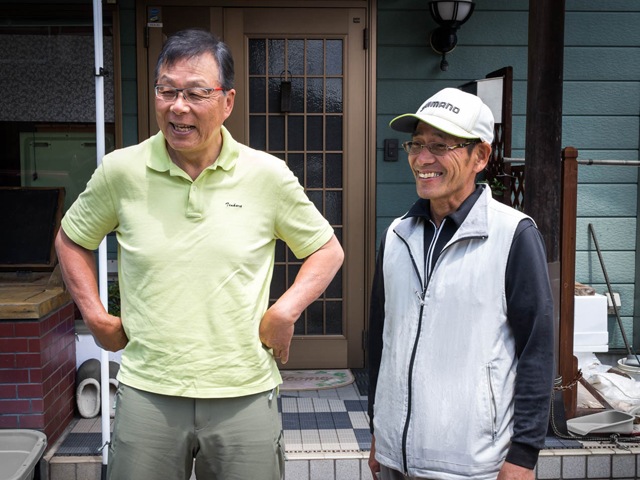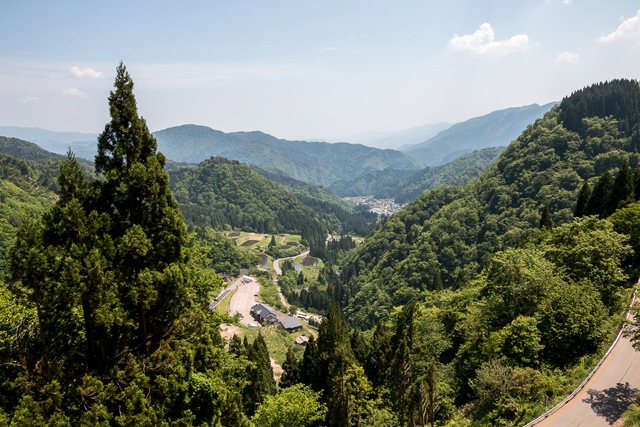I used to think I was a pretty good fly fisher. I even entered some competitions to find out how I stacked up… And while, on paper, I guess I did well, my world-view got blown out the water when Dr Ishigaki introduced me to a true “survival” fly fisher in 2014. Points on paper and catching lots of fish using all the modern gadgets and latest tackle is all very well… Strip that away though and it means NOTHING if you had to make and use a survival fishing kit just from materials you can find.
In that situation, if you don’t have the right skills and knowledge when needed, you’ll die. That’s a sobering thought - and a world away from a game of “fishing for points”.

I didn’t really realise it at the time – but the first meeting with Hisanobu Hirata in his small, fascinating fishing store in the little town of Shiro-Tori (“White Bird”) in Gifu set off a chain reaction in my brain. Here was a man who had started out trying to catch fish for pocket money in the shadow of his father (a truly great professional fly fisher who used tenkara – NOT BAIT FISHING - to support his family).
The Satisfaction of Skills
Why is this important though? Well, imagine having the confidence to only have a bamboo rod and a home-made (horsehair) fly line and a fly (tied without tools or a vice) and STILL know you can beat out the competition and guarantee your family’s survival…What would that kind of ability and confidence feel like?
Now, if you’ve heard his backstory, you’ll know that it didn’t start very well for Hirata-san! He struggled to make the simple tackle “sing” in the way that his father seemed to do so effortlessly. While his dad returned with four or eight kilos of big “amago” (one of the hardest Japanese trout to catch), Hisanobu could generally only catch one or two fish – and these would be unfit to eat at the end of his fishing day.
So How did Hirata-san Win His Happiness?
On the verge of throwing in the towel (and with his father insisting that he would not teach him directly) Hirata-san began to devour information. By sheer talent and force of will he forged himself into a brilliant angler who has had a 50+ year career as a professional tenkara master (first as a professional “Shokuryoshi” catching amago and iwana to order and then, with the growth of fish farming, as a teacher of survival tenkara to private students).

Capturing and breaking down the basic – but truly life-saving – skills of Hirata-san’s “survival” tenkara (from tackle creation to presentation skills and even avoiding eye-contact and the correct mental approach to catching fish!) was a blast. It’s been truly exhausting and inspiring in equal parts and we’ve poured it all into the new...
Having created these publications, we can now say with certainty…
The MOST important Item in a Survival Fishing Kit is Your Knowledge
Any high quality tool is useless if you don’t know how to use it. The strange thing is, the more basic the tool, the more skill is required. If you’re a musician and you can’t cut it with just an acoustic instrument and a single spotlight in a small room, well, you’re basically a phoney. But the satisfaction of being great with just the bare minimum…it means you can move entire stadiums when you’re let loose on the most expensive gear. It is exactly the same in fly fishing (and especially tenkara).
I’m sure that is why now, Hirata-san still fishes in his spare time for pleasure. Not many professionals at any career choice would or could say that. There is great joy and satisfaction in being deeply effective with the simplest tools.
The methods, philosophy and tackle that are such "second nature" to him (and which have sustained his interest for five decades) are the fundamental roots of tenkara. If you want to truly be a tenkara angler (which you may not, and that is fine!), you can't really consider yourself as having real "tenkara understanding" without studying and absorbing the skills that Hirata-san and other "Shokuryoshi school" anglers use. I can guarantee it will sustain your interest and satisfaction the more you learn about it.
So what might be some of the secrets behind Hirata-san’s happiness?
Perhaps I’m wrong, but the things that we wanted to pass on through the bundle contents seem to add up to a happiness and satisfaction that Hirata-san experiences through tenkara (we certainly get a lot out of them). Things like:
- Belonging to a tradition and an extended community who have practised these skills for generations (and the unique connection that is only possible people who share that understanding)
- Having complete confidence in a strong collection of unique and sometimes strange skills (like using the colours of the sky or the riverbed to guide fly choice!). Conjuring fish up using those techniques offers a very satisfying connection with the natural world
- The satisfaction of being able to make and fine-tune tackle from scratch in a similar way to any of our ancient ancestors who used those tools to survive (and especially being able to pass on that ability to other anglers and our children)
- Being recognised and admired as a skilled angler and tackle-maker
has its own satisfaction too (just make sure to not let it go to your
head! Having your kids or grand-kids and friends look up to you is
definitely a powerful ego boost) - Enjoying time on stream to the full: a lifetime spent in and around rivers, watching and fishing intently is a fine thing (and being able to work on our skills even when we can’t fish helps to make the absolute best of that precious time on stream)
I think these deeply satisfying effects come from surprisingly simple practical abilities such as:
- How to create your own perfectly "balanced" horse-hair fly line in about 20 minutes (from scratch and without any special tools)
- How to tie brilliantly-effective flies without a bobbin, without a vice and
only using a cutting blade to trim the end of the thread when finished
(includes diagrams of the special knots and whipping that make this
technique work) - Choosing where in the fish's mouth and how to best set the hook to REDUCE the number of fish you lose during play
- Drawing fish up to your fly where you can watch them take it (a very satisfying way to improve bite detection!)
- Tying just a handful of fly patterns and how bring them to LIFE with skilful presentation (each fly with a particular “job” that they do)
- Making the line and rod work together AND
work with your grip and arm position to create accurate casts and
enticing fly manipulations – these are the most satisfying sensations in
fly fishing and tenkara - Getting your flies and presentations to stand out from those of the Average Joe (just by making small tweaks to the way things are usually done)
- Selecting an effective fly pattern by looking AT THE RIVERBED and then looking AT THE SKY to choose the shade of body
- You'll also learn the story of Hirata-san's "Mamushi" snake-skin kebari and catching 109 fish on it in a day after years of testing with his many students
If you like the sound of having those abilities yourself, then Hirata-san's Masterclass includes all the details of his fly choice tactics, fly tying methods, horsehair line-making instructions and onstream casting, presentation and pro-level hook setting skills.

Wonderful story about how simple equipment can be very efficient when combined with the the right level of knowledge and skill. In situations where if you don’t catch something you don’t eat probably hones the skills more rapidly.
The story reminds me very much of a couple of stories I ran across 10 or so years ago about the local handline anglers in Coast Rica or in Baja Mexico. Who in one story using a hook, chicken feather and beverage can pull tab lure would out fish the tourists arriving by plane with fishing gear that cost hundreds of dollars. And this story that I can still find on-line.
“My most-prized Baja fishing souvenir is an old, traditional panguero’s winding board, just like the ones used by the Mexican fishermen, Chino Zúniga and Abundio Rodriguez, in King Of The Moon.
It’s a plain piece of wood, exactly twelve inches long, three-and-a-half inches wide, and three-quarters of an inch thick; in other words, it’s nothing more a one-foot-long piece of standard one-by-four, probably cut from pine or douglas fir……
Well, if you’ve ever fished with a Mexican panguero, you know the bitter, bitter truth: using his dumb old winding board and his big, ugly bait hooks, he will outfish your fancy store-bought tackle almost every time. Even though it may appear to be just a simple piece of junk, the traditional winding board’s shape and dimensions, the knots, the line, the hooks–everything about it–makes it a highly-evolved piece of fishing machinery, finely tuned to its task, with a man’s livelihood depending on it, and it is supremely efficient and deadly effective….”
You can read the rest of that story here:
http://www.mexfish.com/baja/baja/af020115/af020115.htm .
Half a world away from Japan, and a much different fishing method. But a similar story of how superior skill refines and makes simple gear efficient and effective fishing tackle.
That’s a great story and a perfect comparison David. I think it is always good to remember that we have the extreme luxury of practising fishing for fun if we choose to. What I particularly like about Hirata-san’s story is that, even now that he doesn’t have to catch fish to survive any more, he still chooses to fish for the pleasure and satisfaction he found in his craft.